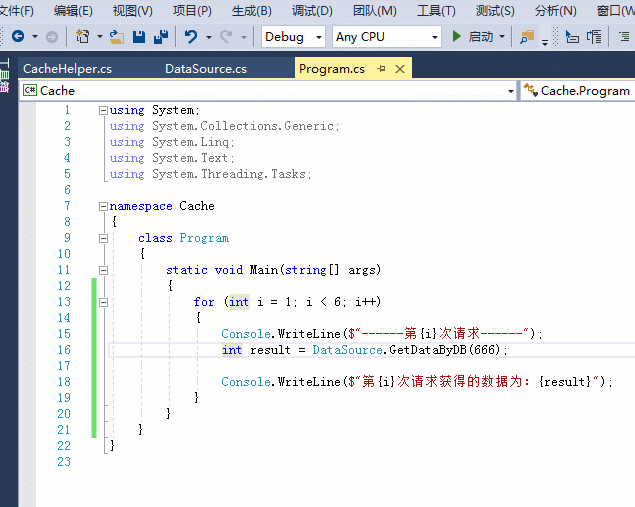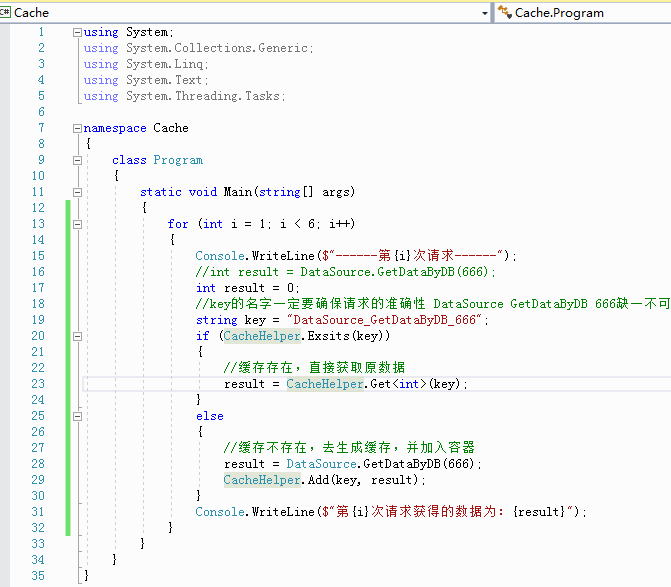项目开发过程中缓存的应用到处可见,下面这篇文章主要给大家介绍了关于C#中缓存的基本使用方法,文中通过示例代码介绍的非常详细,对大家的学习或者工作具有一定的参考学习价值.
前言
缓存主要是为了提高数据的读取速度。因为服务器和应用客户端之间存在着流量瓶颈,所以读取大容量数据时,使用缓存来直接为客户端服务,可以减少客户端与服务器端的数据交互,从而大大提高程序的性能。
缓存这个东西可大可小,小到一个静态的字段,大到将整个数据库Cache起来。项目开发过程中缓存的应用到处可见,本文主要介绍一下使用的方法,下面话不多说了,来一起看看详细的介绍吧
1.在ASP.NET中页面缓存的使用方法简单,只需要在aspx页的顶部加上一句声明即可:
<%@ OutputCache Duration=”100” VaryByParam=”none” %>
Duration:缓存时间(秒为单位),必填属性
2.使用微软自带的类库System.Web.Caching
新手接触的话不建议直接使用微软提供的类库,因为这样对理解不够深刻。所以在这里我带大家自己写一套缓存操作方法,这样理解得更加清晰。
话不多说,代码开敲。
一、首先,先模拟数据来源。新建一个类,写一个数据操作方法(该方法耗时、耗资源)
using System;using System.Collections.Generic;using System.Linq;using System.Text;using System.Threading;using System.Threading.Tasks;namespace Cache{public class CacheDataSource{/// <summary>/// 01.模拟从数据库读取数据/// 02.耗时、耗CPU/// </summary>/// <param name="count"></param>public static int GetDataByDB(int count){Console.WriteLine("-------GetDataByDB-------");int result = 0;for (int i = count; i < 99999999; i++){result += i;}Thread.Sleep(2000);return result;}}}
二、编写一个缓存操作类
2.1 构造一个字典型容器,用于存放缓存数据,权限设为private ,防止随意访问造成数据不安全性
//缓存容器
private static Dictionary
2.2 构造三个方法(添加数据至缓存容器、从缓存容器获取数据、判断缓存是否存在)
using System;using System.Collections.Generic;namespace Cache{public class CacheHelper{/// <summary>/// 缓存容器/// </summary>private static Dictionary<string, object> CacheDictionary = new Dictionary<string, object>();/// <summary>/// 添加缓存/// </summary>public static void Add(string key, object value){CacheDictionary.Add(key, value);}/// <summary>/// 获取缓存/// </summary>public static T Get<T>(string key){return (T)CacheDictionary[key];}/// <summary>/// 判断缓存是否存在/// </summary>/// <param name="key"></param>/// <returns></returns>public static bool Exsits(string key){return CacheDictionary.ContainsKey(key);}}}
三、程序入口编写测试方法
3.1 先看一下普通情况不适用缓存,它的执行效率有多慢
using System;using System.Collections.Generic;using System.Linq;using System.Text;using System.Threading.Tasks;namespace Cache{class Program{static void Main(string[] args){for (int i = 1; i < 6; i++){Console.WriteLine($"------第{i}次请求------");int result = CacheDataSource.GetDataByDB(666);Console.WriteLine($"第{i}次请求获得的数据为:{result}");}}}}
3.2 接下来,我们编写缓存试用方法。概念无非就是根据key前往字典容器里查找是否有相对应缓存数据,有则直接调用,没有则生成并存入字典容器里。
using System;using System.Collections.Generic;using System.Linq;using System.Text;using System.Threading.Tasks;namespace Cache{class Program{static void Main(string[] args){for (int i = 1; i < 6; i++){Console.WriteLine($"------第{i}次请求------");//int result = DataSource.GetDataByDB(666);int result = 0;//key的名字一定要确保请求的准确性 DataSource GetDataByDB 666缺一不可string key = "DataSource_GetDataByDB_666";if (CacheHelper.Exsits(key)){//缓存存在,直接获取原数据result = CacheHelper.Get<int>(key);}else{//缓存不存在,去生成缓存,并加入容器result = CacheDataSource.GetDataByDB(666);CacheHelper.Add(key, result);}Console.WriteLine($"第{i}次请求获得的数据为:{result}");}}}}
3.3 我们看看加入缓存之后的效率如何
四、可以看到,瞬间完成。事已至此,缓存的使用基本是完成了。但是回过头来我们想想看。一个系统成百上千个地方使用缓存的话,那岂不是要写成百上千个if else判断缓存是否存在,然后获取?
4.1 缓存操作类(CacheHelper)编写一个通用的获取方法
using System;using System.Collections.Generic;namespace Cache{public class CacheHelper{/// <summary>/// 缓存获取方法/// </summary>/// <typeparam name="T"></typeparam>/// <param name="key">缓存字典容器对应key</param>/// <param name="func">委托方法 传入操作对象</param>/// <returns></returns>public static T GetCache<T>(string key, Func<T> func){T t = default(T);if (CacheHelper.Exsits(key)){//缓存存在,直接获取原数据t = CacheHelper.Get<T>(key);}else{//缓存不存在,去生成缓存,并加入容器t = func.Invoke();CacheHelper.Add(key, t);}return t;}/// <summary>/// 缓存容器/// </summary>private static Dictionary<string, object> CacheDictionary = new Dictionary<string, object>();/// <summary>/// 添加缓存/// </summary>public static void Add(string key, object value){CacheDictionary.Add(key, value);}/// <summary>/// 获取缓存/// </summary>public static T Get<T>(string key){return (T)CacheDictionary[key];}/// <summary>/// 判断缓存是否存在/// </summary>/// <param name="key"></param>/// <returns></returns>public static bool Exsits(string key){return CacheDictionary.ContainsKey(key);}}}
4.2 程序入口进行调用,传入的委托参数为lamad表达式优化后的代码
到这里,缓存的使用基本结束了。最好值得一提的是,缓存尽量在数据量小、重复查询量大的情况下使用。因为缓存也是要耗内存的,服务器内存是有限的!
using System;using System.Collections.Generic;using System.Linq;using System.Text;using System.Threading.Tasks;namespace Cache{class Program{static void Main(string[] args){for (int i = 1; i < 6; i++){Console.WriteLine($"------第{i}次请求------");int result = 0;//key的名字一定要确保请求的准确性 DataSource GetDataByDB 666缺一不可string key = "DataSource_GetDataByDB_666";//将需要执行的获取数据操作编写成委托传入方法(重点)//Func<int> func = new Func<int>(() => { return DataSource.GetDataByDB(666); });result = CacheHelper.GetCache(key, () => DataSource.GetDataByDB(666));Console.WriteLine($"第{i}次请求获得的数据为:{result}");}}}}
总结
到这里,缓存的使用基本结束了。最好值得一提的是,缓存尽量在数据量小、重复查询量大的情况下使用。因为缓存也是要耗内存的,服务器内存是有限的!



